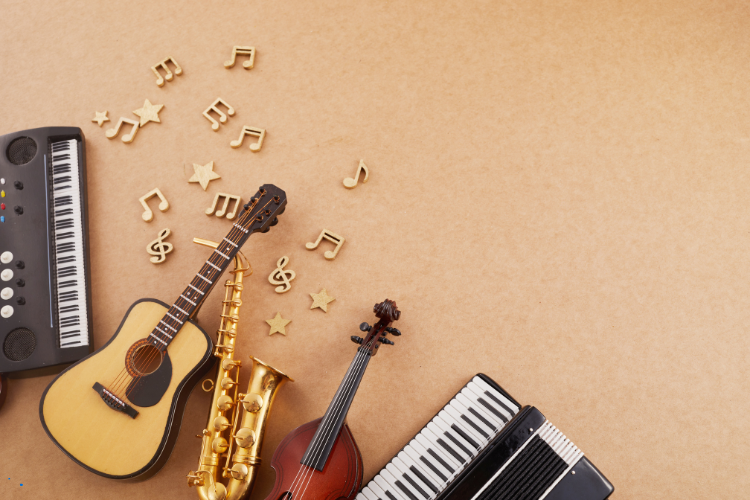Find self-storage near you
Do you need a Removals service?
Best Practices for Storing Musical Instruments in a Self-Storage Unit

Musical instruments are not just tools for musicians—they often hold sentimental and financial value. Whether you’re a seasoned professional or a passionate hobbyist, ensuring your instruments are stored properly can make the difference between keeping them in pristine condition and risking long-term damage. Self-storage units can be a practical option, but storing delicate instruments like guitars, pianos, brass, and woodwinds requires special care. In this guide, we’ll outline comprehensive best practices for storing musical instruments in a self-storage unit, safeguarding them from environmental factors, physical damage, and wear over time.
Choose Climate-Controlled Storage
Musical instruments are particularly sensitive to temperature and humidity changes, which can cause significant damage over time. Wood expands and contracts with temperature shifts, while moisture can cause rust on metal parts or loosen glues used in the construction of instruments. For example, a wooden instrument like a guitar can crack in dry conditions, while a brass instrument might corrode if exposed to excessive humidity.
Best Practice: Always choose a climate-controlled storage unit. These units regulate both temperature and humidity, maintaining optimal conditions to prevent damage. The ideal environment for most instruments is between 16°C and 24°C, with humidity levels around 40% to 60%. For instruments made of wood, such as violins, cellos, and guitars, this level of humidity prevents cracking or warping. Meanwhile, brass and wind instruments are protected from corrosion and rust.
Additional Tip: In regions with extreme weather conditions, climate control becomes even more crucial. If you’re in an area prone to heatwaves, freezing winters, or high humidity, a climate-controlled unit isn’t just a luxury—it’s a necessity.
Clean Your Instruments Before Storing
Leaving your instrument uncleaned before storage can result in long-term damage. Sweat, oils from your hands, and dust particles can build up and lead to corrosion, staining, or deterioration of parts over time. For example, woodwind instruments can develop mould or mildew inside their cases if moisture isn’t properly dried out.
Best Practice: Clean each instrument carefully before storing. Use the appropriate cleaning products for each type of instrument. For brass instruments like trumpets and trombones, apply brass polish to remove fingerprints and oils. For string instruments like guitars and violins, use a dry cloth to wipe down the strings and the body, and consider applying a conditioning oil to the fretboard to keep it from drying out.
Additional Tip: For woodwind instruments, disassemble them before storage and clean each part, particularly the mouthpiece, which can accumulate saliva and bacteria. A thorough cleaning ensures your instrument is in top condition when you take it out of storage.
Loosen Strings and Drums
Instruments under constant tension can suffer from long-term stress, which can cause parts to weaken or break over time. Stringed instruments, for example, can warp if the tension from the strings is left unchanged during storage. Drums, especially those with sensitive drumheads, can stretch or crack if left tightly wound for extended periods.
Best Practice: Loosen the strings on instruments like guitars, violins, and pianos. This reduces the tension on the neck, preventing warping or snapping under pressure. For drum kits, release some of the tension on the drumheads to prevent them from stretching, cracking, or warping due to changes in humidity or temperature.
Additional Tip: For pianos, while loosening the strings is essential, it’s also crucial to cover the keyboard to protect it from dust and dirt during storage. This will prevent keys from becoming sticky or jammed after extended storage periods.
Use Proper Storage Containers and Cases
Your instrument’s case is its first line of defence against damage. While soft cases may be lightweight and convenient for carrying instruments short distances, they offer very little protection against physical damage in storage. Hard cases, on the other hand, are built to withstand impacts, protect against dust, and shield instruments from environmental factors.
Best Practice: Always store your instruments in hard-shell cases specifically designed for them. These cases are padded and shaped to provide maximum protection. If you don’t have a hard case, consider wrapping your instrument in protective materials like bubble wrap and placing it in a sturdy, airtight container.
Additional Tip: If you own rare or vintage instruments, consider investing in cases with extra features, such as humidity-controlled compartments. These offer added protection, particularly for wood instruments that are sensitive to climate changes.
Keep Instruments Elevated and Organized
Even in climate-controlled units, accidents can happen. Flooding, spills, or condensation may occur, and instruments stored directly on the floor are at higher risk of damage. Storing them off the ground offers an additional layer of protection.
Best Practice: Place your instrument cases on shelves, pallets, or raised platforms to keep them off the ground. This protects them from potential water damage and helps with ventilation. Additionally, if you’re storing multiple instruments, make sure they are stacked in a way that prevents them from falling or being crushed. Organize your unit so that heavier instruments or cases are at the bottom, with lighter, more fragile ones on top.
Additional Tip: Avoid stacking too many items on top of each other. While hard cases offer great protection, stacking them can still create pressure that may affect sensitive instruments over time.
Control Humidity with Desiccants
Even in climate-controlled units, humidity levels can fluctuate slightly. Over time, this can affect sensitive instruments, particularly those made of wood or metal. To further control moisture levels, desiccants like silica gel packs can absorb excess moisture inside the instrument cases.
Best Practice: Place desiccant packets inside the cases of wooden instruments like guitars and violins, as well as brass instruments like trumpets. These small moisture absorbers will help regulate the micro-environment inside the case and prevent the buildup of mould, mildew, or rust.
Additional Tip: Monitor and replace the desiccant packs regularly, especially during humid months. If you live in a particularly humid region, consider placing multiple packets inside each case to ensure optimal moisture control.
Inspect Your Instruments Periodically
Just because your instruments are in storage doesn’t mean you can forget about them. Regular check-ins will allow you to catch any issues, like moisture buildup or wear and tear, before they cause serious damage.
Best Practice: Make it a habit to visit your storage unit every few months to inspect your instruments. Check for signs of damage, such as rust, cracks, or warping, and assess whether the storage environment is still suitable. Play your instrument during inspections if possible, as this helps you identify potential issues with sound quality or playability.
Additional Tip: If you notice any slight changes in the instrument’s condition, address them immediately. If humidity seems to be a problem, you may need to adjust the environment inside the case with additional desiccants or take other precautions.
Store Accessories Separately
Accessories such as bows, reeds, cables, and stands are just as important to your musical setup as the instruments themselves. However, these items also need to be stored carefully, as they can be prone to damage from humidity, pests, or simple wear and tear over time.
Best Practice: Store accessories in separate sealed plastic containers or dedicated hard cases. Bows for string instruments, for example, should be loosened and stored properly to prevent the bow hair from losing tension. Sheet music, which is particularly sensitive to moisture, should be stored in airtight plastic containers to prevent dampness or mould.
Additional Tip: Label all containers clearly so you know where everything is when you return to your storage unit. This makes retrieval easier and ensures you don’t accidentally damage an accessory when searching for something else.
Consider Insurance Coverage
Instruments can be incredibly valuable, not only financially but also emotionally. Losing an instrument to theft, natural disasters, or damage can be devastating. While following the best storage practices will significantly reduce risks, accidents can still happen.
Best Practice: If your instrument is particularly valuable, consider insuring it separately under a musical instrument insurance policy. Alternatively, look into whether your homeowner’s or renter’s insurance covers instruments in storage. Insurance offers peace of mind, knowing that even in the worst-case scenario, you’re protected.
Additional Tip: Take detailed photographs of your instruments before placing them in storage. This documentation, along with receipts and appraisals, will help streamline the claims process if anything unfortunate occurs.
Label and Catalogue Everything
When storing multiple instruments and accessories, it’s easy to lose track of what’s where or what condition items are in. This can lead to confusion or damage when moving things in and out of storage.
Best Practice: Keep an organized inventory of everything you store. Label each case and box clearly, and create a catalogue with details about each instrument, including its make, model, and any existing damage before storage. If possible, include photos in your catalogue for easy reference.
Additional Tip: Use a digital inventory app to track what’s in your storage unit. This can save time and help you manage your collection remotely without having to visit the unit regularly.
By following these best practices for storing musical instruments in a self-storage unit, you can rest easy knowing your valuable instruments are protected. Proper preparation, organization, and care will ensure your instruments remain in excellent condition, ready for the next time you play.


